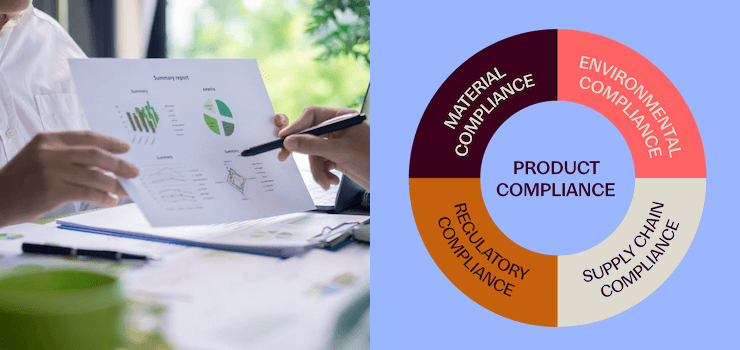Businesses today are no longer grappling with just product compliance or sustainability in isolation. These two dimensions are converging, driven by a growing demand from costumers, regulators, and stakeholders for transparent and responsible operations. Product compliance—traditionally focused on meeting legal requirements and other safety standards—is increasingly overlapping with sustainability goals like reducing environmental impact, ensuring ethical and responsible sourcing, and promoting circularity. Meanwhile, new regulations are continuously emerging to enforce sustainability, making it a mandatory consideration rather than a voluntary effort.
Rising Sustainability Regulations: Transforming Business Operations
Sustainability was once seen as a "nice-to-have" activity, often driven by NGOs and environmental groups, and internally treated as a niche topic. Today, it has transformed into a "must-have" for businesses due to increasing regulations and pressure from stakeholders. With new rules like the Corporate Sustainability Reporting Directive (CSRD), updates of the waste regulations such as WEEE (Waste from Electrical and Electronic Equipment), and end-of-life vehicle (ELV) directive, companies are being legally required to rethink their strategies. Investors, too, are demanding transparency on ESG (Environmental, Social, Governance) metrics.
These regulations are part of a broader wave of global sustainability policies aimed at mitigating risks to human health and the environment. Industry players must now assess the entire lifecycle of their products, considering their impact on air, water, and soil quality, while optimizing the use of limited natural resources.
Companies are now responsible not only for product safety and quality but also for minimizing environmental and social impacts. Managing risks like supply chain disruptions, environmental damage, and resource depletion is crucial. Failure to meet these evolving standards can lead to reputational harm and market exclusion. Consequently, businesses are adopting a more holistic approach, integrating compliance and sustainability to secure their industry standing and contribute to global sustainability goals.
The Integration of Product Compliance and Sustainability
Meeting regulatory standards such as REACH, RoHS, TSCA, or the upcoming legislations for PFAS chemicals, while also reducing the climate impact through Corporate Carbon Footprint (CCF) and Product Carbon Footprints (PCF) and sustainable supply chain practices, requires a unified approach. A centralized data system is crucial for aligning these efforts. Managing compliance and sustainability separately leads to inefficiencies, duplicated work, and makes it challenging to scale. Platforms like IMDS (International Material Data System) enable data collection and integration, particularly in the automotive industry, by consolidating material and substance information across the supply chain.
To effectively integrate product compliance and sustainability, organizations can follow three key steps:
1. Development of a Unified Data Basis
To scale and automate processes, businesses need a shared data system for both product compliance and sustainability. Using different systems increases complexity and effort. A unified system enables efficient management and allows teams to scale their efforts across both areas.
For example, a production engineer can leverage this data to create products that are more sustainable, compliant, and possibly even more cost-efficient. At the same time, this data can be used as a basis for greenhouse gas accounting and Scope 3 emissions reporting, providing the transparency investors need to track the company’s progress towards decarbonization.
2. Define Use Cases for Cross-Functional Practices
The next step is identifying how this unified data will be used across different roles in the company, as this clarity helps streamline data sharing and resource management, enabling departments to work together more efficiently toward responsible and sustainable manufacturing.
One use case is product development - where engineers rely on data to develop compliant and sustainable products. Another critical use case is reporting: companies need accurate data for greenhouse gas emissions reporting and decarbonization tracking, ensuring they can show investors and stakeholders their progress over time.
Additionally, procurement teams need to monitor the supply chain. Companies are increasingly requiring suppliers to meet sustainability standards, such as providing decarbonized materials. A unified system enables procurement to easily check if the supplied materials meet contractual sustainability requirements.
3. Monitoring and Reporting
Beyond use cases, it's essential to continuously monitor and report on both compliance and sustainability efforts. Supply chain oversight is key here, as businesses must ensure that suppliers are meeting environmental standards and that decarbonized materials are being provided. Procurement teams play a vital role in verifying that agreed-upon sustainability commitments are met.
By having these clear use cases and roles, companies can ensure that their approach to product compliance and sustainability is integrated and efficient.
Sustainability and Compliance in Global Supply Chains
One of the greatest challenges is ensuring sustainability across the entire supply chain. Companies need real-time transparency and access to data to monitor whether suppliers are meeting sustainability requirements. This data is crucial for both regulatory compliance and sustainability goals, enabling a more holistic approach to supply chain due diligence. Advanced software and technology solutions can support businesses track and analyze this information, providing the necessary insights to drive operational change and align with sustainability policy throughout the supply chain.
From Impact Intelligence to Product Stewardship: A Unified Approach to the Future
To stay competitive and meet evolving environmental and regulatory requirements, companies must move beyond reactive compliance and siloed sustainability initiatives. The new Impact Intelligence White Paper shows how organizations can shift from simply responding to regulations toward actively shaping sustainable product strategies — powered by connected data, integrated processes, and a unified framework for compliance, sustainability, and ESG performance.
By linking product, material, and supplier data across the supply chain, businesses gain a shared understanding of environmental and social impact across the entire life cycle. This holistic approach enhances transparency, strengthens collaboration between engineering, procurement, and sustainability teams, and supports smarter, measurable progress toward corporate sustainability goals.

Download the White Paper “Impact Intelligence: The Steering Logic for Compliance & Sustainability” to learn how companies can transform compliance pressure into strategic advantage — and move from reacting to actively driving sustainable product stewardship.
With our comprehensive product stewardship software solutions, we provide the tools necessary to streamline this integration, enabling real-time monitoring and management of compliance and sustainability efforts through unified data control and processing, automated carbon footprinting and life cycle assessments, ultimately ensuring that companies meet regulatory requirements and optimize supply chain performance and risk management.






.png)
